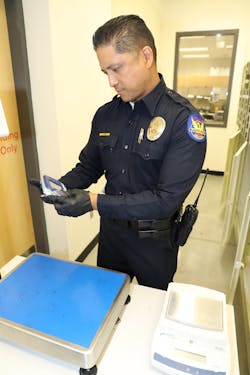How 3 PDs Invested in Tech in the Fight Against Crime
Hollywood, Florida PD and Coral Springs, Florida PD
By David Volz
The purchase
Police departments are using license plate readers in the fight against crime. The Hollywood (Fla.) Police Department reports success with its automated license plate reader by way of Vigilant Solutions and CCTV camera program.Since the program went into effect in the parking area of a section known as North Beach in 2016, crime, especially car burglaries and thefts, has gone down by about 90 percent in the first quarter of 2017.
For comparison, during the first quarter 2016 there were 20 burglaries and two in the same period this year. With many vehicle burglaries in the area over the years the City of Hollywood also placed signs in the parking lot stating that the area was under video surveillance.
The installation
Hollywood Police Chief Tomas Sanchez gave positive remarks about the program during City Commission meetings. Now, the second phase of the license plate reader program will soon be installed in the downtown section of Hollywood. Phase three will be placed on Federal Highway U.S. 1, a major road in the city. Eventually the license plate readers will be placed throughout Hollywood. The cameras are mounted on police cars, mobile units or on poles.
Hollywood Police Detective Daniel Justus explains that police officers have access to the reports generated by the cameras. Hollywood police also gain information from other cities that have license plate reader programs. In fact, they can be on the lookout for stolen cars that might come from other cities. “We get monthly license plate readouts. It lets you know about stolen vehicles. If a car is stolen, the license plate is entered into a national database and [the stolen vehicle] can be tracked as soon as it gets to Hollywood,” says Justus.
All Hollywood police cars have access to license plate readers, meaning an officer on patrol can know immediately if a stolen car is being driven nearby. Software for the license plate readers has been installed in all police vehicles. “We are focusing on areas that have had many car thefts,” he says. “We have tripled the number of arrests for car thefts.”
How it works
The system operates by using high speed cameras combined with computer algorithms which convert images of license plates into computer readable data. This data is compared with data provided by the Florida Department of Law Enforcement (FDLE) which may include the following: missing or endangered persons, Amber alerts, Silver alerts, stolen vehicles, terrorist information and other intelligence information important to law enforcement. If a license plate inquiry matches one provided by the FDLE, an alert is sent from the location of the camera and computer to officers’ mobile computer terminals and the police department dispatch center. An image of the license plate and the vehicle is attached in the alert. It is important to note that a tentative alert must be verified visually. All characters must be exact and must match the license plate that was originally entered. Only then can the alert be further verified.
If a police officer visually observes the vehicle, contact with the vehicle and subject can only be made after further verification is completed. Further verification includes a confirmation of the license plate as being valid and active by the original entering agency through the Florida Crime Information Center/National Crime Information Center. This is the database where information of this type is entered by all agencies. The system reads license plates and license plates only. The collected license plate recognition (LPR) data contains no personally identifiable information to connect a license plate detection to an individual. The license plate reader system has identified many stolen vehicles, stolen license plates and wanted persons. It has helped police locate many vehicles which have been recovered or subjects taken into custody, according to Bradley McKeone, a captain with the Coral Springs Police Department, which also uses LPR technology.
The results
Tom Joyce, vice president for Vigilant Solutions, says license plate readers give police departments an effective tool to collect and analyze data. “License plate readers provide massive amounts of data to law enforcement agencies. This enables agencies to close more cases and close them faster,” he notes. These readers also help to promote officer safety. “They are very helpful because they provide real time alerts of potential high threat encounters,” says Joyce. “They can help law enforcement in narcotics investigations and asset seizures.”
Phoenix, Arizona Police Department
By Adrienne Zimmer
The purchase
The Phoenix (Ariz.) Police Department purchased the Thermo Scientific TruNarc handheld narcotics analyzer. Though the initial purchase was for two TruNarc analyzers in early 2013, the department has purchased nine additional TruNarc analyzers since that time. “The initial investment was around $40,000,” says Alan Pfohl, sergeant in the Phoenix Police Department. “Anecdotally, the number of heroin items submitted to the laboratory for in-custody analysis has decreased. Also, the total number of items field tested by officers has increased since switching to TruNarc.”
The decision process
The department had no other proposals and evaluated the TruNarc for six weeks after seeing a demo with its bomb squad, which uses other Thermo Fisher devices for their work. “The TruNarc analyzer provided a viable field testing solution for heroin, oxycodone and morphine, which was of interest to the Maricopa County Attorney’s Office,” says Pfohl. “The TruNarc also provided a viable solution for testing other commonly encountered street drugs such as diazepam, carisoprodol and methamphetamine.”
The results
The TruNarc handheld narcotics analyzer has allowed the department’s field testing program to expand from four to 21 drugs which can be tested in the field, reports Pfohl. It has also provided a means to field test heroin and other opiates which have seen an increase in street usage since 2011.
Phoenix police officers are testing approximately 7,000 to 10,000 items per year and 85 percent of the defendants are pleading guilty. “By using TruNarc, officers are able to book suspects and get them into the justice system immediately rather than wait for lab results and then hope they can find the suspect when the results come in,” says Pfohl. “The TruNarc system saves time, since the officers don’t have to complete special lab requests for analysis, and it helps save money for our department. We have cut lab costs by a projected $22,000 per month, which is a potential savings of $1.3 million over five years.”
Advice
Pfohl recommends partnering with your local crime laboratory and district attorney’s office. “Learn what street drugs in your area work well with TruNarc and which ones pose challenges to the technology,” he says. “Once you have made the decision to purchase, partner with other local law enforcement agencies to help provide training. Phoenix was the first law enforcement agency in Arizona to use TruNarc and we have since helped train other agencies in the valley.”
David Volz
David Volz has been a writer about 30 years, with work appearing in the Sun Sentinel, Physician’s Financial News, Made to Measure, the Uniform Magazine, Occupational Therapy, Engraver’s Journal and other publications. He teaches Communications at Miami Dade College and Broward College and has an MA in Communications from Florida Atlantic University.

Adrienne Zimmer | Editor
Adrienne Zimmer was the Editor of Law Enforcement Technology magazine, a monthly business-to-business publication that covers technology trends and best practices for public safety managers from 2017 to 2019. LET is part of Officer Media Group, which also publishes Law Enforcement Product News and Officer.com. Adrienne has been in publishing since 2013.



